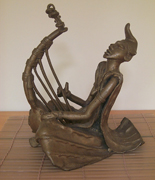HISTORY OF THE COLLECTION
Courses in music outside the Western classical canon began at Oberlin in 1971 with the first faculty appointment in ethnomusicology, Sara Stalder. As an Indian music specialist, she purchased several sets of tabla for teaching purposes. Also in 1971, Oberlin bought a Javanese gamelan—a set of bronze keyed instruments and gongs. Oberlin's ethnomusicology offerings and instrument collecting had begun.
In 1976 Sara Stalder left Oberlin and Roderic Knight succeeded her. One of Knight's research interests is organology, or the scientific study of musical instruments. He began collecting instruments already as a high school student and continued throughout his career, regarding instruments as the "trophies" of ethnomusicology, typically returning from field work with his hands full. He was a student of Klaus Wachsmann, translator into English of the revered Hornbostel-Sachs instrument classification system, and as an instrumentalist himself, understood the value of having tangible items to take to class.
In 2008, upon his retirement, Knight donated his personal collection of instruments, some 200 in number, to the conservatory. In addition to collecting instruments to take to class, he also purchased instruments to be used in performing ensembles, especially his own, in African and Indian music. Knight's personal collection and the instruments purchased for ensembles make up the bulk of the collection. The gamelan is not itemized in the collection, but is described in a separate link: Oberlin Javanese Gamelan. A final component of the collection is a body of instruments collected by other faculty or friends and given to Oberlin, some dating long before the introduction of courses.
Although the collection has been growing for several decades, it was not identified as such until 2007, when Knight offered a year-long seminar in organology, dedicated in part to the task of preparing a catalog. Now catalogued, the collection is still used as it has always been: many instruments are in active use in ensembles, others are displayed from time to time, all might be taken to class for demonstration purposes, and all are available for individual study by students. The collection also serves to demonstrate the Knight Revision of Hornbostel-Sachs musical instrument classification system (see K-Rev Classification). Queries about the collection are welcome. Please email rknight@oberlin.edu.

